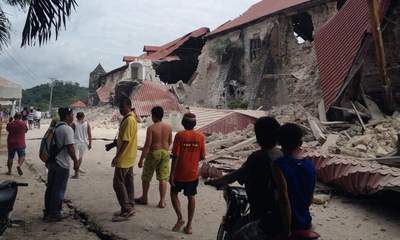Philippines Earthquake: At Least 93 Dead

The death toll from a 7.2 magnitude earthquake that struck the Philippines continues to rise with at least 93 people now reported killed.
Most of the fatalities occurred at the tremor’s epicentre on the central island of Bohol, where rescuers are struggling to reach patients in a collapsed hospital.
People have also died on the neighbouring islands of Cebu and Siquijor.
The earthquake has caused widespread damage to buildings, left many areas without power, and cut transport links.
Bridges and roads have been left impassable, frustrating rescue efforts, while historic churches dating from the Spanish colonial period have also been hit.
Among them was the country's oldest, the 16th century Basilica of the Holy Child in Cebu, which lost its bell tower.
The quake struck at 8.12am local time, at a depth of 20 miles (33km) below Carmen town on Bohol.
Renato Solidum, head of the state seismology agency, said: "A magnitude 7 earthquake has energy equivalent to around 32 Hiroshima atomic bombs.
"Compared to the 2010 Haiti earthquake that had a magnitude of 7.0, this one had a magnitude of 7.2, slightly stronger."
Bohol police chief Dennis Agustin said 77 people had died in 11 towns on the island, which is popular among foreigners because of its beach and island resorts, and famed "Chocolate Hills".
The highest number of dead - 18 - were in the municipality of Loon, 26 miles (42km) west of Carmen, where an unknown number of patients were trapped inside a hospital, which partially collapsed.
Rescuers were working to reach them, said civil defence spokesman Major Reynaldo Balido.
Densely populated Cebu city, across a narrow strait from Bohol, also saw extensive damage caused when a building in the port and the roof of a market area collapsed.
At least 15 people died on Cebu, and another on Siquijor, which attracts tourists with its pristine white sands.
Authorities were setting up tents for those displaced by the quake, while others who lost their homes moved in with their relatives, Bohol Governor Edgardo Chatto said.
Describing the moment the quake struck, Vilma Yorong, a provincial government employee in Bohol, said: "We ran out of the building, and outside, we hugged trees because the tremors were so strong.
"When the shaking stopped, I ran to the street and there I saw several injured people. Some were saying their church has collapsed."
Offices and schools were closed for a national holiday - the Muslim festival of Eid - which may have saved lives.
Another eye-witness Aledel Cuizon said the quake sounded like "a huge truck that was approaching and the rumbling sound grew louder as it got closer."
She and her neighbours ran outside, where she saw concrete electric poles "swaying like coconut trees." It lasted 15-20 seconds, she said.
The earthquake was followed by at least four aftershocks measuring more than 5.0 in magnitude.
Cebu city's hospitals quickly moved patients into the streets, basketball courts and parks.
Soldiers have been recalled from leave to respond to the civil emergency, while President Benigno Aquino said he plans to visit earthquake-damaged areas.
The Philippines lies on the so-called Pacific Ring of Fire, a chain of islands that are prone to quakes and volcanic eruptions.
The deadliest recorded natural disaster occurred in 1976, when a tsunami triggered by a magnitude 7.9 earthquake devastated the Moro Gulf on the southern island of Mindanao.
Between 5,000 and 8,000 people were killed, according to official estimates.

 Yahoo News
Yahoo News 